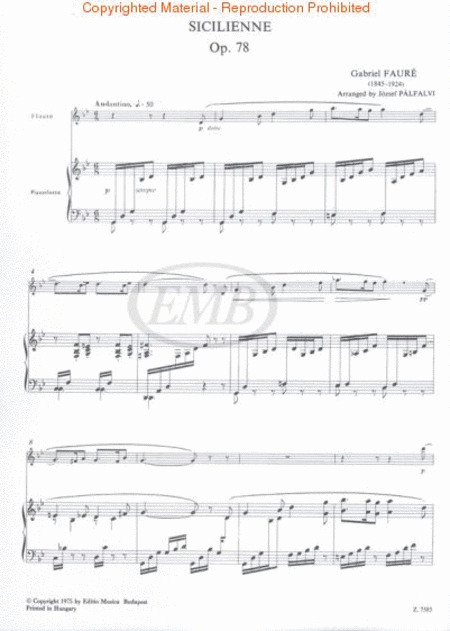
Happy Present Meet
Faure Sicilienne Op.78 for Flute and Piano
Revised by Jeney Zoltán id.
Transcribed by Pálfalvi József
One of the most popular works by French composer Gabriel Fauré (1845-1924) is the Op. 78 Sicilienne. Fauré originally wrote the work in 1893 as incidental music to Moliere's drama Le Bourgeois gentilhomme, but the theatre went bankrupt before it could be performed. A few years later in 1898 the composer reworked the movement for cello and piano, at the same time making an orchestral version which he incorporated into the incidental music for Maeterlinck's Pelléas et Mélisande. In 1909 Fauré made this into a four-movement orchestral suite (Op. 80), with the Sicilienne as the third movement, where it attained its final form. Since then, transcriptions of the work have been made for a wide variety of instruments.
The word sicilienne is the French term for the Italian siciliano, signifying a pastoral character piece. Its characteristic features are the time signature of 6/8 or 12/8, dotted rhythms, and an intimate yet often melancholy mood.
프랑스 작곡가 가브리엘 포레(1845-1924)의 가장 인기 있는 작품 중 하나는 Op. 78 Sicilienne입니다. 포레는 원래 1893년 몰리에르의 희곡 Le Bourgeois gentilhomme의 부수음악으로 이 작품을 작곡했지만, 공연되기 전에 극장이 파산했습니다. 몇 년 후인 1898년, 작곡가는 이 악장을 첼로와 피아노를 위해 개작하는 동시에 관현악 버전으로도 작곡하여 메테를링크의 Pelléas et Mélisande의 부수음악에 포함시켰습니다. 1909년, 포레는 이 작품을 4악장 관현악 모음곡(Op. 80)으로 만들었는데, 이 중 Sicilienne을 3악장으로 하여 최종적인 형태를 갖추게 되었습니다. 그 이후로 이 작품은 다양한 악기를 위한 편곡으로 만들어졌습니다.
'sicilienne'은 이탈리아어 'siciliano'의 프랑스어로, 전원적인 성격의 곡을 의미합니다. 이 곡의 특징은 6/8 또는 12/8 박자표, 점박자 리듬, 친밀하면서도 종종 우울한 분위기입니다.
작곡가 Faure, Gabriel (1845-1924)
에디터 Jeney, Zoltan id.
Palfalui, Jeney

Schocker 3 Dances for 2 Flutes and Piano
Muczynski Moments Op.47 for Flute and Piano
Schumann Symphony No.2 Op.61 (Miniature Score)
[특가상품] Boehm 24 Caprices Op.26 for Flute Solo
Taffanel and Gaubert 17 Big Daily Finger Exercises for Flute Solo
Faure Berceuse Op.16 for Flute (or Oboe, Clarinet) and Piano
Debussy Clair de Lune for Flute and Piano
Franck Sonata in A Major for Flute and Piano
Mendelssohn A Midsummer Night`s Dream Op.61 (Miniature Score)